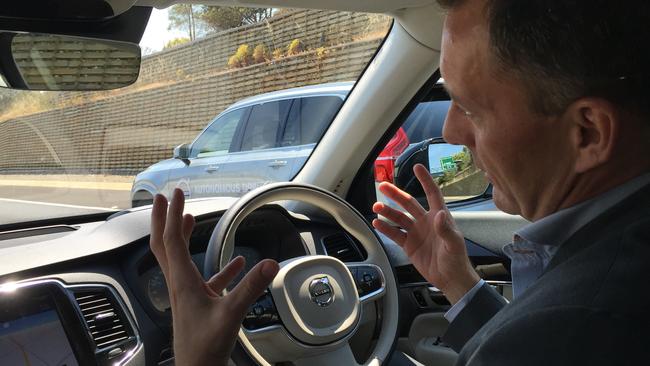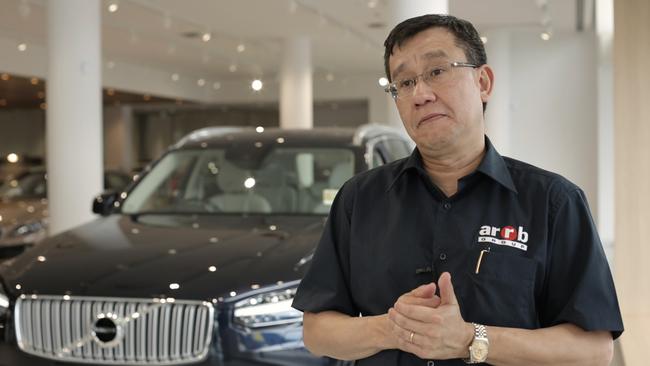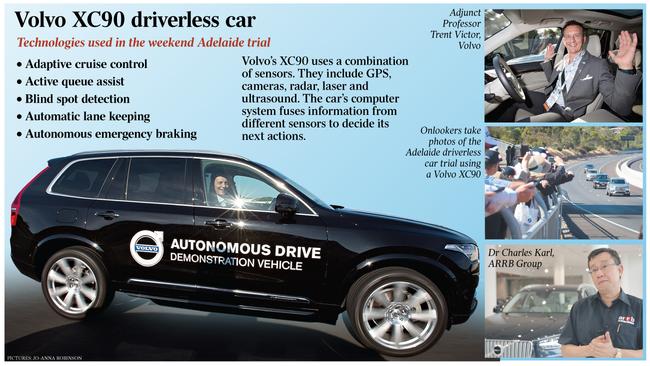Driverless technology hints at a hands-free future
The next step in the evolution of cars is all about the convergence of technologies that have been around for some time.
How much technology is needed for a car to be driverless? That question was partly answered as I hurtled along Adelaide’s Southern Expressway in a driverless car at the weekend.
It was the first official driverless car outing on an Australian public road and as I got comfortable in the Volvo XC90, it seemed my relative lack of trepidation wasn’t entirely shared by my fellow passengers.
South Australia’s Premier, Jay Wetherill, for one, was deep in conversation with Volvo’s safety analysis guru, Trent Victor, who was in the driver’s seat but wasn’t doing much driving.
So was the ride a heart-stopper? Not quite, mainly because we were travelling in ideal conditions, along a well-marked section of blocked-off highway with a large concrete median strip.
The only traffic was two other XC90s used for testing scenarios such as driving ahead and behind us, and changing lanes. What’s interesting, however, is the technology that underpins this next step in the evolution of cars, where the dashboard becomes that little bit more important than the steering wheel.
It’s all about the convergence of technologies that have been around for some time but are now ready to take centre stage. Take, for example, adaptive cruise control. It’s been available n Volvos since 2010 and in the trial, the driverless car’s speed automatically increased to the designated cruise control speed after the vehicle ahead changed lanes, leaving the path clear.
360° video of the historic driverless vehicle journey with South Australia Premier Jay Wetherill. Drag your cursor across the video to see the car and its participants from all angles. You will need Google Chrome or Firefox to view it.
In a fully driverless world, where cars communicate their positions to one another, it might be possible to reduce inter-vehicle distances.
Then there’s active queue assist for heavy traffic situations. If a car ahead stops, you automatically stop. If the other car then moves off, your car moves off and maintains a fixed distance behind.
Features like blind spot detection rely on sensors at the back and during the test drive, a red line appeared on the side mirror warning the driver when overtaking would be dangerous. Meanwhile, automatic lane-keeping detects the car’s position on the road using several technologies. In the XC90, it uses cameras and lane markings to work out the bounds within which the car travels.
City safety, also called autonomous emergency braking, is collision avoidance technology that warns of pedestrians and other obstacles. Volvo recently upgraded it for night time use. Earlier versions used lasers but the XC90 uses radar and a camera and will automatically brake to avoid a collision. Newer implementations seek to eliminate false positives — braking when there is no imminent collision.
Volvo is increasing the range of obstacles that can be detected and has researchers in Australia studying movements of kangaroos.

The XC90 used on Saturday didn’t change lanes automatically. That’s something the latest Tesla is somewhat proficient at but Volvo says it will deliver that functionality over time.
In autonomous cars, Volvo will add Drive Me, which uses a three-dimensional digital map and a cloud-based data system to more accurately pinpoint a car’s position. Volvo regards this as sufficient for the XC90 to operate autonomously in restricted circumstances, such as freeway travelling. But driving on a busy city road is another matter, and a separate challenge ahead.
In fact, the trials in Adelaide provide just a glimpse of where we are headed and there’s still plenty of ground that needs to be covered before the fully autonomous car becomes a reality. For now, and in the near future, cars will not operate in driverless mode everywhere. In Australia, nominated road sections will be certified for driverless use. Line markings, pavements, signage, lighting and traffic management systems will need to be upgraded.
The next big development is linking driverless transport systems. Road research body ARRB Group national technical leader Charles Karl says the seamless connectivity will need to be the key as a driverless car’s computer would interact wirelessly with road infrastructure, other cars and other transport systems.

It’s the sort of co-ordination that implicitly relies on closer collaboration between networks and Dr Karl says fostering harmonious interplay between diverse networks will be more important than developing any centrally controlled traffic management system. It’s more likely to be an ecosystem of different systems that are connected in the cloud and information can be shared among them.
“There will be sensors; there will be integration, and interlinked systems,” he says.
The big unknown here is the security of the data and Dr Karl admits there’s still plenty that needs to be done on that front.
Then there’s the additional element of whether we can trust humans to use autonomous driving technology wisely.
Tesla chief executive Elon Musk has flagged constraints such as making it mandatory for someone to be in the driver’s seat and there have been cases of drivers abusing the current Tesla autopilot system.
Volvo’s version of autonomous driving may not be as elaborate as some, but it looks achievable in Australia and offers a glimpse of the future.




To join the conversation, please log in. Don't have an account? Register
Join the conversation, you are commenting as Logout